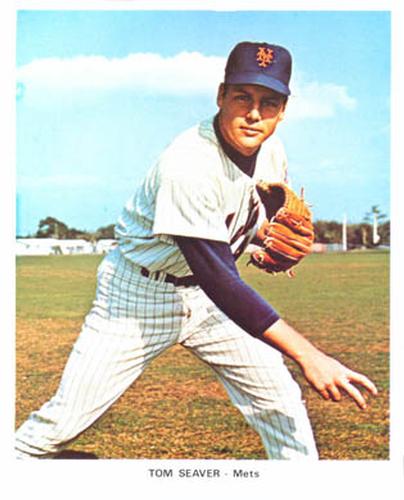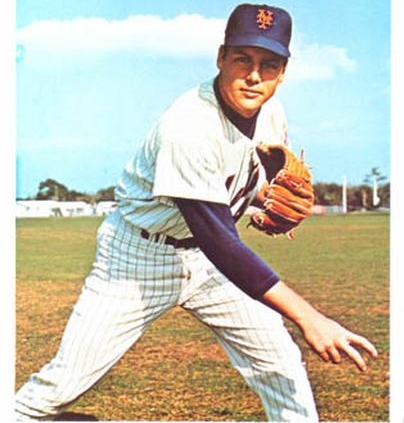July 4, 1972: Tom Seaver loses no-hitter in ninth inning on Independence Day
 When fireworks launched on America’s 196th birthday, the nighttime celebration was an afterthought for Mets fans. Earlier in the day, Tom Seaver gave them another reason to rejoice when he took a no-hitter into the ninth inning against the San Diego Padres; Leron Lee’s one-out, broken-bat single prevented the Mets ace from getting his first no-hitter. “As soon as he hit it, I knew it was a hit,” said Seaver. “At least I had the satisfaction of having him break his bat.”1
When fireworks launched on America’s 196th birthday, the nighttime celebration was an afterthought for Mets fans. Earlier in the day, Tom Seaver gave them another reason to rejoice when he took a no-hitter into the ninth inning against the San Diego Padres; Leron Lee’s one-out, broken-bat single prevented the Mets ace from getting his first no-hitter. “As soon as he hit it, I knew it was a hit,” said Seaver. “At least I had the satisfaction of having him break his bat.”1
Seaver faced San Diego on five days’ rest instead of the traditional four — he had been scheduled to pitch in the previous day’s doubleheader against the Montreal Expos, but it was rained out.
New York did not have its usual power in the lineup — Cleon Jones, Tommie Agee, and Rusty Staub were sidelined with injuries. Willie Mays and John Milner had pulled muscles, but they played.2
The Mets beat the Padres 2-0, scoring both runs on a two-out rally in the bottom of the third inning. Righty Clay Kirby struck out Seaver and sent Mays — who had come to New York in May in a trade with the Giants — back to the bench on a 6-3 play. Bud Harrelson singled and stole second base; Kirby loaded the bases with walks to Wayne Garrett and Milner.
Jim Fregosi got the third consecutive walk, which scored Harrelson and made Padres manager Don Zimmer angrier than Elmer Fudd when he got outwitted by Bugs Bunny. Zimmer’s argument about ball four being a strike resulted in home-plate umpire Lee Weyer tossing the skipper from the game.3
Kirby walked home another run when he gave his fourth straight pass of the inning to Ed Kranepool. Gary Ross, a fellow right-hander, relieved Kirby and ended the inning on Ted Martinez’s 4-6 grounder.
Bill Greif replaced Ross in the bottom of the sixth; Mays led off with a single and went to second when Padres catcher Pat Corrales misplayed a pitch for a passed ball. No longer the Say-Hey Kid of old, the 41-year-old Mays was thrown out at third when right fielder Cito Gaston caught Harrelson’s line drive and sent it to Dave Roberts at third for a double play.
Seaver’s fourth one-hitter4 included 11 strikeouts and three fly balls. Until Lee’s fly out to center field in the seventh, though, no balls went to the outfield.5 But the blue-and-orange-clad fans at Shea Stadium felt a palpable nervousness when their legendary hurler walked pinch-hitters Larry Stahl and Garry Jestadt with two outs in the top of the eighth. Derrel Thomas’s liner to Martinez in right field squashed that threat.
The two walks meant that Seaver had to face Roberts, Lee, and cleanup batter Nate Colbert in the top of the ninth. Colbert was a power hitter along the lines of Mickey Mantle and Dave Kingman — formidable home-run totals with a high number of strikeouts. In 1972 he hit 38 homers, struck out 127 times, and hit .250. But Lee’s .300 average led the ’72 Padres. Seaver said, “[Colbert] hits all of us good, but me he wears out. Why? I dunno. We make too many mistakes with him. We don’t pitch him right.”6
It turned out that Colbert wasn’t a highly significant problem for Seaver that afternoon: 0-for-3 with one walk. Roberts’s 4-3 grounder preceded Lee’s broken-bat, first-pitch single; but Colbert grounded into a 6-4-3 double play; and Mets fans relaxed. Seaver described the fateful pitch to Lee as “down and in on the inside of the plate.”7
Lee ended his major-league career after the 1976 season with a .250 lifetime average. His tenure included stints with the Cardinals, Padres, Indians, and Dodgers. But he continued playing baseball in the Mexican League with Monterrey in 1976 and became a cornerstone of the Lotte Orions in the Japan Pacific League from 1977 to 1987. His career average in Japan was .320, with 283 home runs. In Nippon Professional Baseball, the Japanese major leagues, Lee had the highest career batting average with at least 4,000 at-bats until Norichika Aoki broke the record in 2018.8
Seaver’s one-hitter began a 3-6 homestand that disheartened fans of New York’s National League ballclub, which finished the season at 83-73. It was the first game of a holiday doubleheader; San Diego won the second game, 4-2. In addition to the Independence Day holiday, it was also Navy Day at Shea Stadium; Miss Navy provided sex appeal for the patriotic-minded.9
Seaver began 1972 with four straight wins; his shutout of the Padres improved his record to 11-4. His excellence manifested in a 21-12 record and second place in National League in strikeouts. Said fellow Mets hurler Jim McAndrew, “He was a child-god to me. We all admired and respected him, while at the same time were jealous of him too. You’re thinking, Gee, I wish I could do what he does. It’s kind of like taking an exam, and there’s a kid that always gets A’s, and you get B’s.”10
For Mets fans, Seaver was a reliable cornerstone offering a joyous escape from the headlines. In the month before the July Fourth game, the Watergate scandal arose when five men were arrested on burglary charges involving the Democratic National Committee headquarters; Jane Fonda made her controversial tour of North Vietnam culminating in photographs of her on the type of antiaircraft gun used to attack American troops; and 117 people died when Hurricane Agnes slammed into Florida and went northward along the East Coast.
Further, the Mets community suffered a tragedy at the beginning of the season when manager Gil Hodges died of a heart attack on April 2 (two days before his 48th birthday); Yogi Berra succeeded him. Seaver et al. lost the leader who instilled professionalism and pride, refusing to acknowledge the “lovable losers” descriptor associated with the Mets since 1962. When Hodges took over in 1968, fans from Jackson Heights to JFK International Airport felt a sobriety hinting at a promising future.
Under Hodges’s tutelage, the Mets defied conventional wisdom and beat the Orioles in five games to win the 1969 World Series. In 2011 Seaver said of Hodges, “He was the most important man of my career.”11
Sources
The author used Baseball Reference.com and Retrosheet.org for box scores and play-by-play information.
baseball-reference.com/boxes/NYN/NYN197207041.shtml
retrosheet.org/boxesetc/1972/B07041NYN1972.htm
Notes
1 Neil Hershberg (United Press International), “Mets Stop Padres on Seaver’s 1-Hitter,” Santa Rosa (California) Press Democrat, July 5, 1972: 18.
2 Murray Chass, “Seaver Loses No-Hit Bid in 9th to Lee’s Single, but Scores, 2-0: Padres Take 2d Game, 4-2, on Two-Run 9th, New York Times, July 5, 1972: 47
3 Zimmer got a promotion from coach to manager in late April when the Padres fired Preston Gomez.
4 Seaver pitched five one-hitters with the Mets and a no-hitter with the Reds.
5 Chass.
6 Milton Richman (United Press International), “Seaver’s Day Perfect Without No-Hitter,” Jersey Journal (Jersey City, New Jersey), July 5, 1972: 38.
7 Joe O’Day, “Mets Take Opener, 2-0; Lose 2d, 4-2,” New York Daily News, July 5, 1972: 98.
8 Leron Lee, Baseball Reference, https://baseball-reference.com/bullpen/Leron_Lee.
9 “July 4, 1972,” The Ultimate Mets Database, https://ultimatemets.com/metannual.php?ThisYear=1972&tabno=4.
10 Art Shamsky with Erik Sherman, After the Miracle: The Lasting Brotherhood of the ’69 Mets (New York: Simon & Schuster, 2019), 76.
11 Freddy Vasquez, “Tom Seaver Endorses Gil Hodges for The Hall of Fame,” Mets Hot Corner, January 8, 2016, https://metshotcorner.com/2016/tom-seaver-endorses-gil-hodges-for-the-hall-of-fame/.
Additional Stats
New York Mets 2
San Diego Padres 0
Game 1, DH
Shea Stadium
New York, NY
Box Score + PBP:
Corrections? Additions?
If you can help us improve this game story, contact us.


